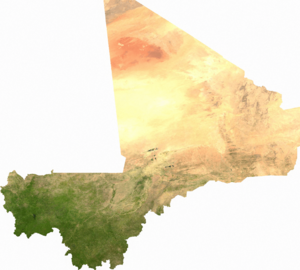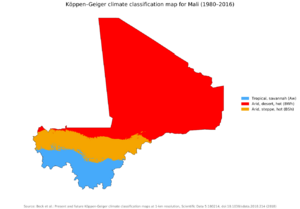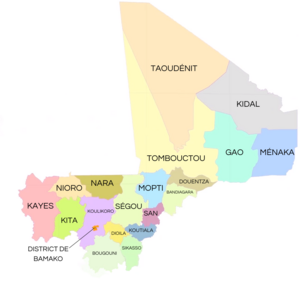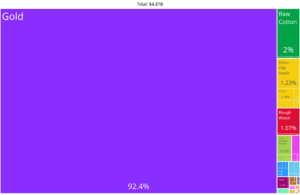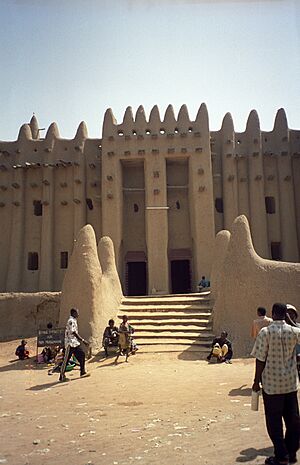Mali facts for kids
Quick facts for kids
Republic of Mali
|
|
|---|---|
|
|
|
|
Motto: "Un peuple, un but, une foi" (French)
"Mɔgɔ kelen, laɲini kelen, dannaya kelen" (Bambara) "One people, one goal, one faith" |
|
|
Anthem: "Le Mali" (French)
|
|
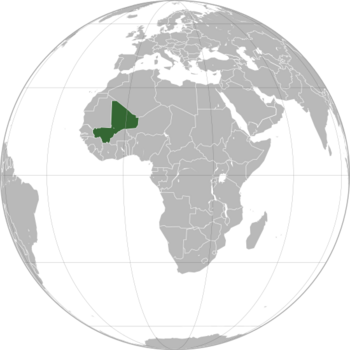
Location of Mali (green)
|
|
| Capital and largest city
|
Bamako 12°39′N 8°0′W / 12.650°N 8.000°W |
| Official languages | 13 national languages |
| Working language |
|
| Spoken languages | |
| Ethnic groups | |
| Religion
(2021)
|
|
| Demonym(s) | Malian |
| Government | Unitary presidential republic under a military junta |
| Assimi Goïta (interim) | |
| Abdoulaye Maïga (interim) | |
| Legislature | National Assembly |
| Formation | |
|
• Establishment of the Sudanese Republic
|
24 November 1958 |
|
• Merger with Senegal to create the Mali Federation
|
4 April 1959 |
|
• Independence from France
|
20 June 1960 |
|
• Dissolution of the Mali Federation
|
20 August 1960 |
|
• Declaration of the Republic of Mali
|
22 September 1960 |
| Area | |
|
• Total
|
1,240,192 km2 (478,841 sq mi) (23rd) |
|
• Water (%)
|
1.6 |
| Population | |
|
• 2024 estimate
|
21,990,607 (61st) |
|
• Density
|
11.7/km2 (30.3/sq mi) (215th) |
| GDP (PPP) | 2023 estimate |
|
• Total
|
|
|
• Per capita
|
|
| GDP (nominal) | 2023 estimate |
|
• Total
|
|
|
• Per capita
|
|
| Gini (2010) | 33.0 medium |
| HDI (2022) | low · 188th |
| Currency | West African CFA franc (XOF) |
| Time zone | UTC (GMT) |
| Date format | dd/mm/yyyy |
| Driving side | right |
| Calling code | +223 |
| ISO 3166 code | ML |
| Internet TLD | .ml |
Mali, officially the Republic of Mali, is a country in West Africa. It is a landlocked country, meaning it has no coastline. Mali is the eighth-largest country in Africa. It covers an area of over 1.2 million square kilometers (478,839 sq mi).
Mali shares borders with seven other countries. To the north is Algeria, and to the east is Niger. To the northwest, it borders Mauritania. In the south, you'll find Burkina Faso and Ivory Coast. To the west are Guinea and Senegal.
Mali has a population of about 24.5 million people. Its capital and largest city is Bamako. The country has 13 official languages. Bambara is the most widely spoken.
Contents
- What's in a Name? The Meaning of Mali
- Mali's Rich History
- Exploring Mali's Geography
- How Mali is Governed
- Regions of Mali
- Mali's Economy
- Getting Around: Transport in Mali
- People of Mali: Demographics
- Major Cities in Mali
- Mali's Diverse Ethnic Groups
- Languages Spoken in Mali
- Religion in Mali
- Mali's Vibrant Culture
- Images for kids
- See also
What's in a Name? The Meaning of Mali
The name Mali comes from the ancient Mali Empire. It means "the place where the king lives." This name also suggests strength.
A traveler named Ibn Battuta visited Mali in the 1300s. He said the empire's capital was called Mali. Some stories say the first emperor, Sundiata Keita, turned into a hippopotamus when he died. This happened in the Sankarani River. People say there were villages near this river called "old Mali." There's even a village called Malikoma, meaning "New Mali." This suggests Mali might have once been a city's name.
Another idea is that Mali is how the Fulani people say the name of the Mande peoples.
Mali's Rich History
Mali was once home to three very powerful and rich West African empires. These empires controlled the important trans-Saharan trade routes.
- The Ghana Empire
- The Mali Empire
- The Songhai Empire
At its strongest in 1300, the Mali Empire was one of Africa's wealthiest places. Its emperor, Mansa Musa, is thought to be one of the richest people ever. Mali was also a center for Islam, culture, and learning. Timbuktu became famous for its university. This university is one of the oldest in the world and is still active today.
The Songhai Empire took over the Mali Empire in 1468. Later, an army from Morocco defeated the Songhai in 1591.
In the late 1800s, France took control of Mali. It became part of French Sudan. In 1960, Mali gained independence. It briefly joined with Senegal to form the Mali Federation. When Senegal left, the Republic of Mali was created.
After many years of one-party rule, a change in government happened in 1991. This led to a new constitution. Mali then became a democratic country with many political parties.
In 2012, an armed conflict began in northern Mali. Some groups took control of land there. There were also changes in the military leadership in March 2012. French forces helped Mali in January 2013. They helped Mali take back most of the northern areas. The conflict continued, but elections were held later that year. In the early 2020s, Mali saw two more changes in military leadership led by Assimi Goïta.
Exploring Mali's Geography
Mali is a landlocked country in West Africa. It is southwest of Algeria. Mali is between 10° and 25°N latitude and 13°W and 5°E longitude.
Mali is the 24th-largest country in the world. It is the eighth-largest country in Africa. Its size is similar to South Africa. Most of Mali is in the southern Sahara Desert. This area is very hot and dusty. Mali is mostly flat with rolling plains covered by sand. The Adrar des Ifoghas mountains are in the northeast.
Mali is one of the hottest countries in the world. Most of Mali gets very little rain. Dry periods are common. The rainy season is from late April to early October in the south. During this time, the Niger River often floods. This creates the Inner Niger Delta.
The northern desert has a hot desert climate. Summers are long and extremely hot. Rainfall is very low and decreases as you go north. The central area has a hot semi-arid climate. It has high temperatures all year. There is a long dry season and a short, irregular rainy season. The southern areas have a tropical wet and dry climate.
Mali has many natural resources. Gold, uranium, phosphates, kaolinite, salt, and limestone are found there. Mali is thought to have over 17,400 tonnes of uranium. In 2012, more uranium was found in the north.
Mali faces several environmental challenges. These include desertification (land turning into desert), deforestation (losing forests), soil erosion, and not enough clean potable water.
Mali's Amazing Biodiversity
Mali has five different natural areas called ecoregions. These include savannas, woodlands, and a unique flooded grassland around the Niger River. In 2019, Mali scored 7.16 out of 10 for its forest health. This ranked it 51st globally.
How Mali is Governed
Until 2012, Mali was a constitutional democracy. It was guided by its 1992 Constitution. This constitution separated powers into three branches:
- The executive (the president and government)
- The legislative (the law-making body)
- The judicial (the courts)
The president was elected for a five-year term. They could serve a maximum of two terms. The president is the head of state and leads the armed forces. A prime minister, chosen by the president, leads the government. The prime minister then chooses the Council of Ministers.
Mali's main law-making body is the National Assembly. It has members elected for five-year terms. The assembly meets twice a year to discuss and vote on new laws.
Mali's constitution also says the courts should be independent. However, the executive branch still has some influence. This is because they appoint judges and oversee how laws are enforced. The highest courts are the Supreme Court and the Constitutional Court. In rural areas, village chiefs and elders often help solve local problems.
Currently, Mali is led by a military junta. This means a group of military leaders is in charge of the government. The current interim President is Assimi Goïta.
Regions of Mali
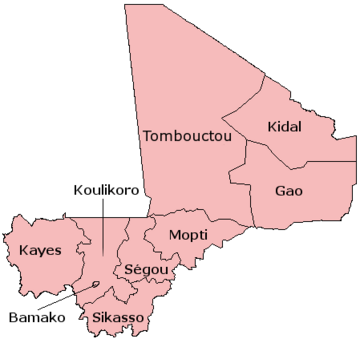
Since 2016, Mali has been divided into ten regions and the District of Bamako. Each region has a governor. New regions like Taoudénit and Ménaka were created in 2016.
Since 2023, Mali has added nine more regions. This brings the total to 19 regions, plus the capital district of Bamako. This change helps improve how the country is run. It also brings public services closer to the people. These 19 regions are then divided into 159 smaller areas called cercles. These are further divided into 815 communes.
The régions and Capital District are:
| No | Region name | Area (km2) | Population Census 2023 |
|---|---|---|---|
| 00 | Bamako Capital District |
252 | 4 227 569 |
| 01 | Kayes | 62,914 | 1 840 329 |
| 02 | Koulikoro | 71,178 | 2 255 157 |
| 03 | Sikasso | 21,378 | 1 533 123 |
| 04 | Ségou | 31,996 | 2 455 263 |
| 05 | Mopti | 49,077 | 935 579 |
| 06 | Tombouctou | 180,781 | 974 278 |
| 07 | Gao | 89,532 | 727 517 |
| 08 | Kidal | 151,430 | 83 192 |
| 09 | Taoudénit | 323,326 | 100 358 |
| 10 | Ménaka | 81,040 | 318 876 |
| 11 | Bougouni | 41,052 | 1 570 979 |
| 12 | Dioila | 12,984 | 675 965 |
| 13 | Nioro | 24,179 | 678 061 |
| 14 | Koutiala | 14,739 | 1 169 882 |
| 15 | Kita | 44,175 | 681 671 |
| 16 | Nara | 26,213 | 307 777 |
| 17 | Bandiagara | 25,709 | 868 916 |
| 18 | San | 15,516 | 820 807 |
| 19 | Douentza | 63,515 | 170 189 |
| Total | 1,240,192 | 22 395 489 | |
Mali's Economy
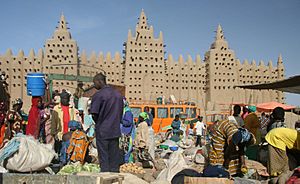
Mali's main industry is agriculture. Cotton is the country's biggest crop export. It is sent to Senegal and Ivory Coast. Mali also grows rice, millet, corn, vegetables, and tobacco.
About 80% of workers in Mali are in agriculture. Another 15% work in the service sector.
Gold is mined in southern Mali. Mali is the third-largest gold producer in Africa. In 2015, Mali produced 41 metric tons of gold. Gold has become Mali's top export since 1999. This has helped the country's economy. Other natural resources include kaolin, salt, phosphate, and limestone.
Mali uses hydroelectricity for more than half of its power. This is a clean way to make electricity.
Getting Around: Transport in Mali
Mali has a railway that connects to neighboring countries. There are also about 29 airports. Eight of these have paved runways. In cities, you'll see many green and white taxicabs. Many people in Mali rely on public transportation to get around.
People of Mali: Demographics
In 2024, Mali's population was estimated to be about 24.5 million people. Most people (68% in 2002) live in rural areas. A small part of the population (5%–10%) are nomadic. Over 90% of Malians live in the southern part of the country. The capital city, Bamako, has over 2 million residents.
Major Cities in Mali
|
Largest cities or towns in Mali
According to the 2009 Census |
||
|---|---|---|
| Rank | Name | Pop. |
| 1 | Bamako | 1,810,366 |
| 2 | Sikasso | 226,618 |
| 3 | Koutiala | 141,444 |
| 4 | Ségou | 133,501 |
| 5 | Kayes | 126,319 |
| 6 | Mopti | 120,786 |
| 7 | Kalabancoro | 96,173 |
| 8 | Gao | 86,353 |
| 9 | Kati | 84,500 |
| 10 | San | 66,967 |
Mali's Diverse Ethnic Groups

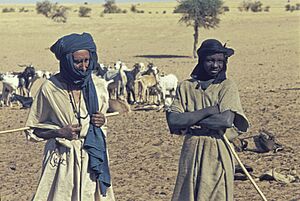
Mali is home to many different ethnic groups from sub-Saharan Africa. The Bambara are the largest group. They make up about a third of the population.
Other large ethnic groups include:
- Fulani (13.3%)
- Sarakole/Soninke/Marka (9.8%)
- Senufo/Manianka (9.6%)
- Malinke (8.8%)
- Dogon (8.7%)
- Songhai (5.9%)
- Tuareg (3.5%)
- Bobo (2.1%)
In Mali and Niger, the Moors are also called Azawagh Arabs. They speak mainly Hassaniya Arabic.
Languages Spoken in Mali
In January 2022, the Malian government announced that Bambara would become an official language. In July 2023, French changed from an official language to a working language.
At the same time, 13 national languages became official languages. These include:
- Bambara
- Bobo
- Bozo
- Dogon
- Fula
- Hassaniya Arabic
- Kassonke
- Maninke
- Minyanka
- Senufo
- The Songhay languages
- Soninke
- Tamasheq
Bambara is the most common language for communication in Mali. About 80% of people can speak it. Over 40 other African languages are spoken by different ethnic groups in Mali.
Religion in Mali
About 90% of Malians are Muslims. Most of them follow the Sunni branch of Islam. About 5% are Christian. This includes about two-thirds Roman Catholic and one-third Protestant. The remaining 5% follow traditional African religions, like the Dogon religion. Most Malians practice their religion every day. It is rare for people in Mali to not believe in any religion.
Mali's Vibrant Culture
Malian culture is very diverse. It reflects the many ethnic groups and different parts of the country. Most Malians wear long, colorful robes called boubous. These are common in West Africa. Malians often take part in traditional festivals, dances, and ceremonies.
Music of Mali
Malian music comes from the griots. Griots are known as "Keepers of Memories." Malian music is rich and has many different styles. Famous Malian musicians include:
- Toumani Diabaté, a master of the kora (a stringed instrument)
- Bassekou Kouyate, a master of the electric jeli ngoni
- The late blues guitarist Ali Farka Touré
- The Tuareg band Tinariwen
- Khaira Arby
- Afro-pop artists like Salif Keita, Amadou et Mariam, Oumou Sangare, Fatoumata Diawara, Rokia Traore, and Habib Koité.
Dance is also a big part of Malian culture. Dance parties are common among friends. Traditional mask dances are performed at special events.
Literature in Mali
Mali has a strong tradition of storytelling. Its literature is often passed down by word of mouth. Jalis (storytellers) recite or sing histories and stories they know by heart. Amadou Hampâté Bâ, a famous Malian historian, spent his life writing down these oral traditions.
One well-known novel by a Malian writer is Yambo Ouologuem's Le devoir de violence. Other famous Malian writers include Baba Traoré, Modibo Sounkalo Keita, Massa Makan Diabaté, Moussa Konaté, and Fily Dabo Sissoko.
Sports in Mali
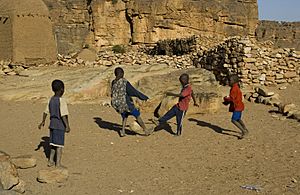
The most popular sport in Mali is association football (soccer). Its popularity grew after Mali hosted the 2002 African Cup of Nations. Most towns and cities have regular games. The most popular teams are Djoliba AC, Stade Malien, and Real Bamako. All these teams are based in the capital city. Kids often play informal games using a bundle of rags as a ball.
Basketball is another major sport. The Mali women's national basketball team played in the 2008 Beijing Olympics. Traditional wrestling (la lutte) is also common. The game wari, a board game, is a popular pastime.
Mali also has a men's national team for beach volleyball. They competed in the 2018–2020 CAVB Beach Volleyball Continental Cup.
Malian Cuisine
Rice and millet are the main foods in Malian cuisine. Meals are often based on grains. Grains are usually served with sauces made from edible leaves, like spinach or baobab. Tomato peanut sauce is also common. Meals might include grilled meat, such as chicken, mutton, beef, or goat. Malian food can be different depending on the region. Other popular dishes include fufu, jollof rice, and maafe.
Images for kids
-
The extent of the Mali Empire's peak
-
The pages above are from Timbuktu Manuscripts written in Sudani script (a form of Arabic) from the Mali Empire showing established knowledge of astronomy and mathematics. Today there are close to a million of these manuscripts found in Timbuktu alone.
-
Griots of Sambala, king of Médina (Fula people, Mali), 1890
-
Members of the National Committee for the Salvation of the People, directory of the ruling junta in Mali
See also
 In Spanish: Malí para niños
In Spanish: Malí para niños




